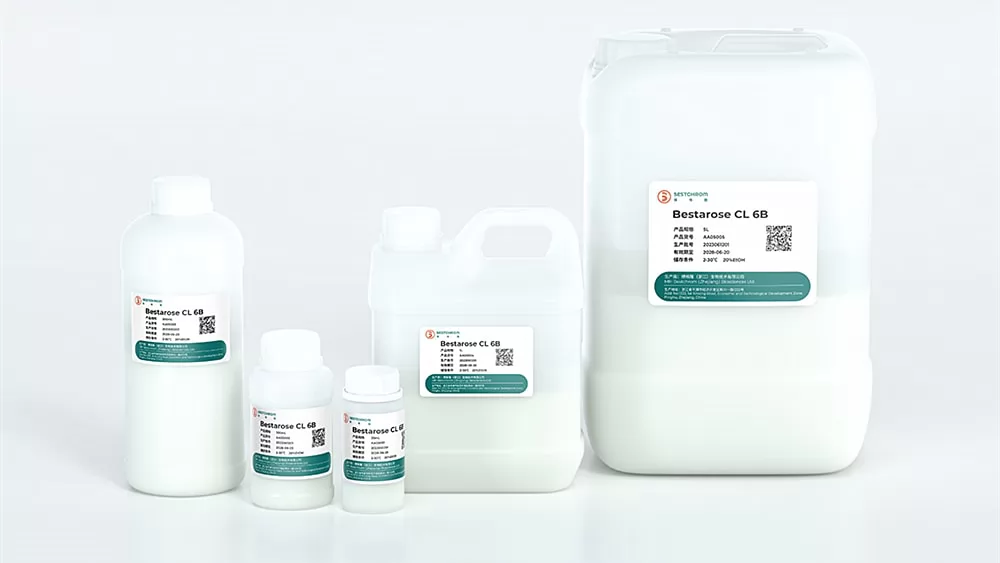What is size exclusion chromatography resin? 2024 Ultimate Guide

Article directory
-
What are size exclusion chromatography resins?
-
How do size exclusion chromatography resins work?
-
What are the characteristics of size exclusion chromatography resin?
-
Main uses of size exclusion chromatography resins
-
What are the benefits of using size exclusion chromatography resins?
-
What types of SEC resins are available?
-
Why use size exclusion chromatography resins?
-
What is the price of size exclusion resins?
-
FAQs about size exclusion chromatography resins
-
Conclusion
What are size exclusion chromatography resins?
Size exclusion resins play a pivotal role as packing materials within columns designated for size exclusion chromatography (SEC). This analytical technique, alternatively referred to as molecular sieve chromatography or gel filtration chromatography, functions to segregate diverse molecules within a mixture based on their respective sizes or molecular weights. It is notably employed for the separation of proteins, peptides, antibodies, and water-soluble polymers.
These specialized resins boast an intricate structure featuring pores of varied dimensions, meticulously crafted by closely packing beads. Typically composed of a diverse array of polymers including agarose, dextran, and polyacrylamide, SEC resins offer a nuanced platform for molecular separation.
How do size exclusion chromatography resins work?
SEC resins are characterized by a porous matrix comprised of spherical particles, or beads, which exhibit a notable absence of reactivity and adsorptive properties. Following the introduction of the sample into the chromatographic column, molecules exceeding the dimensions of the pores face hindrance in diffusing into the beads, leading to their early elution. The varying degrees of penetration into the pores are dictated by the size of molecules falling within the intermediate range between substantial and minute.
In the event a molecule proves smaller than the smallest pore within the resin, it gains access to the complete pore volume. Consequently, molecules that successfully infiltrate the total pore volume exhibit a delayed elution, emerging last in the chromatographic process. Noteworthy is the isocratic elution of samples, obviating the necessity for deploying diverse buffers throughout the separation procedure.
What are the characteristics of size exclusion chromatography resin?
Here are some characteristics of size-exclusion chromatography resins:
✔ Pore Size Distribution: Size exclusion chromatography resins have a range of pore sizes within the stationary phase. This distribution allows for the separation of molecules based on their size. Larger molecules are excluded from the pores and elute first, while smaller molecules penetrate deeper into the resin and elute later.
✔ Hydrophilicity: Size exclusion chromatography resins are often hydrophilic to ensure good solvation of the sample molecules. This helps prevent non-specific interactions between the resin and the sample.
Main uses of size exclusion chromatography resins
The primary applications of size exclusion chromatography (SEC) resins encompass the desalting of feedstock, the elimination of aggregates in the conclusive polishing stage, and the purification of viruses. In a broad context, SEC resins are employed for the fractionation and purification of both synthetic and biological polymers, including proteins, polysaccharides, and nucleic acids, with size serving as the fundamental criterion.
Typically integrated with other resins, SEC resins collaborate to further segregate molecules based on distinctive characteristics such as isoelectric point (pI), charge, and affinity for specific compounds. This amalgamation of resins is commonly implemented as a pivotal polishing step in purification protocols, contributing to the comprehensive refinement of the target substances.
What are the benefits of using size exclusion chromatography resins?
Size exclusion chromatography (SEC) resins offer several benefits for the separation and analysis of macromolecules. Here are some of the key advantages:
Advantage 1: Size Exclusion Chromatography (SEC) separates molecules by size, prioritizing larger ones, and aiding in the analysis of polymers, proteins, nucleic acids, and other macromolecules based on their size or molecular weight.
Advantage 2: SEC is non-destructive, preserving the structure and activity of biomolecules, making it advantageous for sensitive substances like proteins or enzymes, unlike methods with harsh conditions.
Advantage 3: SEC, with well-defined resin particle sizes, achieves high-resolution separations crucial for precision in analytical applications.
Advantage 4: SEC resins are versatile, accommodating various macromolecules, and suitable for analytical and preparative scale separations. This adaptability is valuable for routine analyses and complex research applications.
What types of SEC resins are available?
✔ Bestdex G resins: smaller number in resin names indicates the higher level of cross-linking in resin, providing smaller pore size and a narrower fractionation range. Bestdex resins are widely used in the desalting and buffer exchange of bio-samples including protein, polysaccharide, and nucleic acid as well as the purification of bio-molecules including peptides, oligonucleotides, natural products, and synthetic drugs.
✔ Bestdex LH-20 is obtained by coupling hydroxypropyl functional groups on Bestdex G-25F matrix. The introduced hydroxypropyl functional groups provide resin with better hydrophilicity and lipophilicity, making using organic solvents as mobile phase possible. In addition, Bestdex LH-20 is ideal for the chromatographic process of natural substances as well as the polishing of synthetic drugs.
✔ Bestarose 4B/6B are SEC resins obtained on the matrix of 4% agarose and 6% agarose respectively, after going through emulsification, rinsing, and screening. They enjoy low non-specific adsorption and a wider fractionation range due to the soft matrix, making them ideal for the separation of samples with diversity in Mol. wt. while requiring relatively low resolution. The resins are widely applicable in the chromatographic separation and detection of macro-biomolecules including polysaccharides, nucleic acid, and viruses.
✔ Bestarose CL-4B and Bestarose CL-6B are SEC resins obtained by coupling 2,3-Dibromopropanol to Bestarose 4B and Bestarose 6B matrixes respectively via bi-functional crosslinker. Possessing the same fractionation range as Bestarose 4B/6B resins, Bestarose CL-4B/CL-6B enjoys significantly improved mechanical and chemical properties, enabling the chromatographic separation of samples containing organic solvents as well as tolerance towards strong CIP and 121℃ autoclaving.
✔ Bestarise FF resin is obtained on the Bestarose 4B/6B matrix via a bi-functional cross-linker. Compared with Bestarose CL-4B/CL-6B, it enjoys better mechanic properties due to a higher level of cross-linking. The resin enjoys advantages including tolerance towards 121℃ autoclaving and a fast flow rate, making it ideal for chromatographic purification on a large scale.
✔ Chromdex resins: highly cross-linked agarose as a matrix, filled with cross-linked dextran. Its 34μm bead size makes it rank the top in SEC resins in terms of selectivity and resolution. In addition, the resin enjoys other advantages including high rigidity, fast flow rate, excellent mechanical and chemical property as well and low non-specific adsorption, making it ideal for the polishing of bio-molecules.
Why use size exclusion chromatography resins?
Size exclusion chromatography (SEC) resins are employed for their capacity to separate macromolecules based on size or molecular weight, making them particularly useful for the analysis of polymers, proteins, and nucleic acids. The non-destructive nature of SEC preserves the structure and activity of biomolecules, especially crucial for sensitive substances like proteins or enzymes. With high-resolution separations facilitated by well-defined particle sizes, SEC ensures accurate and reliable results in analytical applications.
The versatility of SEC resins extends to a wide range of macromolecules, allowing their application in both analytical and preparative scale separations. Furthermore, the reproducibility of results, mild operating conditions, scalability, and complementarity with other chromatographic techniques contribute to the widespread use of SEC resins in diverse scientific and industrial contexts.
What is the price of size exclusion resins?
Different types, pore sizes, capacities, purities, brands, and special features all affect the final price of size exclusion resins.
In 2024, prices typically range from $100 to $600 per 100 mL for research-scale applications, while industrial-scale applications range from $5,000 to $30,000 per 10 L. By considering the specific requirements of your application and comparing options from different suppliers, you can find the most cost-effective solution to meet your size exclusion chromatography needs.
Whether you are a scientific technician or an industrial manufacturer, don’t just focus on price, but also consider matching your project plans.
FAQs about size exclusion chromatography resins
Here are answers to some frequently asked questions about size exclusion resins.
What does size exclusion chromatography resin do?
Size exclusion chromatography separates biomolecules according to their molecular size using filtration through a resin that contains spherical beads.
What is a size exclusion resin?
Size exclusion resins are stationary phases that help isolate biomolecules based on their shape or size and molecular weight.
What is the exclusion limit of an SEC resin?
The exclusion limit and fractionation range are important parameters for size exclusion resins. The exclusion limit of the resin tells you the largest molecule size that can pass through the matrix pores and elute in the void volume. The fractionation range defines the range of molecular weights that have partial access to the pores of the particle and can be separated.
How do you select a resin for size exclusion chromatography?
Select resins based on the resolution and yield you need. We offer resins for preparative and analytical SEC. If you have any needs, you can contact us directly or visit our chromatography resin product page!
Conclusion
That’s all there is to know about size exclusion chromatography resins. If you have the idea of purchasing size exclusion chromatography resin in the near future. Then you can visit our product page.
We are a chromatography resin manufacturer and supplier from China, able to provide you with various specifications of chromatography resin. If you need, please contact us. We'll provide you with a free quote!









.png)


